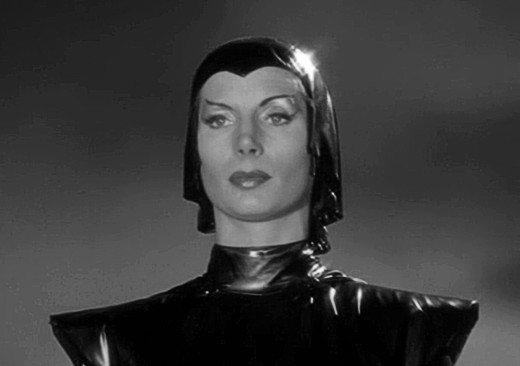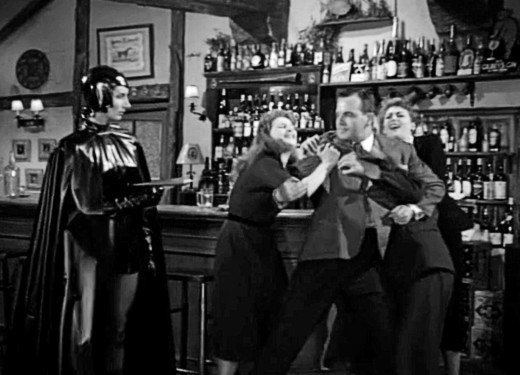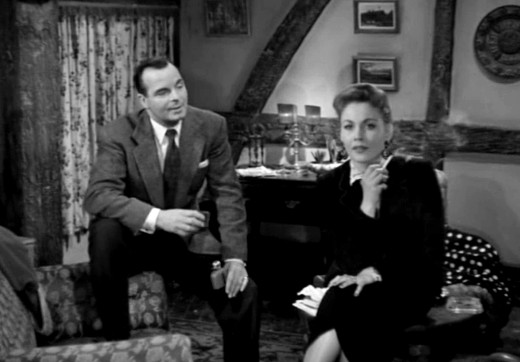Pros: Briskly paced; cool spaceship design; the Devil Girl appeals to the adolescent in all of us
Cons: The scary robot is underutilized; tries to cram too many subplots into its short runtime
Astonishingly, my first two Astonishing Alien Robot Invasion posts have proved to be pretty popular, leading the way in page views in the last year or so (see them here and here). I referenced the Devil Girl and her faithful robot sidekick in both parts of the series, so it’s time for the Martian duo to get their own post.
Admittedly, “invasion” is somewhat an exaggeration in describing the Devil Girl’s mission. Kidnapping is more accurate, but then, what is kidnapping if not an invasion of someone’s personal space, security and bodily integrity?
Also, there’s just the one robot in this one, and not an army (or even a platoon) hunting down humans and doing nasty things to them. And unlike the first two films in the series, where the robots’ masters are never seen, this robot’s mistress, the Devil Girl, is front and center, strutting around in a tight-fitting black leather outfit and boots that look like they were salvaged from… well, I think you know what I’m talking about.
But enough about differences -- the Devil Girl’s metallic sidekick qualifies as an alien robot invader, and that’s that.
For a low budget B in which all the action takes place in one location -- an inn in a remote corner of the Scottish Highlands -- Devil Girl packs a lot of characters, back stories, scientific jargon, love affairs and assorted high drama into its short 77 minute run-time.
Okay, pay attention, because there will be a quiz later. Within the opening 20 minutes or so, all sorts of characters and plot lines converge on the quaint Scottish inn:
- Convicted wife-murderer Robert “It was an accident” Justin, aka Albert Simpson (Peter Reynolds), has escaped from custody and sought shelter at the inn, where his girlfriend/mistress Doris (Adrienne Cori) works. Doris introduces him to everyone as a hiker.
- Prof. Hennessey, an astrophysicist (Joseph Tomelty), and news reporter Michael Carter (Hugh McDermott) have been driving around the countryside investigating reports of a meteor (which will soon be revealed as something else entirely). They get lost, and end up seeking shelter at the inn.
- A glamorous London fashion model, Ellen Preswick (Hazel Court) is already at the inn, trying to find peace and solitude after a break-up with her boyfriend.
- As if that weren’t enough, innkeepers Mr. and Mrs. Jamieson (John Laurie and Sophie Stewart) also have their young nephew Tommy (Anthony Richmond) staying with them. It doesn’t help that Mr. Jamieson likes to take a nip from his own bar inventory whenever he can.
 |
| The Devil Girl isn't sure if she's walked onto the set of a sci-fi movie or a soap opera. |
Whew! This all sets the stage for the Devil Girl’s spectacular entrance (spectacular for a ‘50s B movie at any rate). Michael, the newspaper reporter, recognizes Albert as the escaped convict, and just as he’s about to expose him, a sudden bright light and thunderous noise overhead distracts everyone.
A spaceship lands outside the inn in a tumult of retro-rocket fire, smoke and wailing mechanical noise. In typical fashion, the professor confesses that he’s baffled by the thing, preferring to believe that it’s some sort of experimental plane or guided missile rather than a spaceship from another planet. But the phone is dead and the car won’t start, so it starts to dawn on the assembled guests that conventional explanations won’t do.
Cue the Devil Girl (Patricia Laffan), who emerges from the spacecraft looking absolutely fabulous in a black headpiece and matching cape. She slowly saunters down the gangplank like a supermodel on a fashion show runway.
After dispatching the poor, crippled handyman with a disintegrator ray, she makes her grand entrance at the inn. As the professor and Michael look on slack-jawed, the imperious visitor introduces herself as Nyah, a Martian. She had been headed for London, but had miscalculated and lost a piece of her ship after encountering a thicker than expected atmosphere. (?!)
Nyah matter-of-factly explains that females became the rulers of Mars after a devastating war of the sexes, but that since then males have been declining and the birth rate has plummeted. Her mission is to collect red-blooded earth males to take back to Mars to rejuvenate the population.
In spite of the miscalculations that landed her in the middle of nowhere, Nyah has quite an array of super-scientific technology and powers at her disposal, including the aforementioned disintegrator ray-gun, telepathic mind control, force fields, and a lumbering, 10-foot-tall robot that can shoot a disintegrator beam out of its see-through, dome-like head.
In a lengthy sequence Nyah has her robot companion disintegrate a tree, a truck and a tool shed in order to intimidate the locals (shades of Klaatu and Gort from a few years earlier, except that those aliens only used their power after being attacked).
 |
| The Devil Girl and her robot use the Scottish Highlands for target practice. |
Supremely confident in her superiority, Nyah is not content to sit quietly, sip coffee and thumb through a magazine while waiting for her ship to be repaired. She keeps barging into that most sacred of British inner sanctums, the tavern at the inn, hurling insults at the “puny” and “demented” humans (see my post on The Earth Dies Screaming for more on the local pub as a safe refuge in UK sci-fi and horror films).
But she oversteps when she kidnaps sweet, innocent Tommy, threatening to take him back to Mars, and at that point the humans are ready to stop cowering and fight back. She also miscalculates when she takes the professor on a tour of her ship to further brag about the might and power of Mars. She’s especially proud of the ship’s “perpetual motion” power source. The old scientist, whom Nyah had earlier called “a very poor specimen,” makes a mental note of this possible Achilles heel. Every scrap of information is vital if the “puny” humans are to have a chance at stopping the invasion and preventing earth’s virile males from being abducted to Mars.
Just like The Brain from Planet Arous that I wrote about recently, the Devil Girl is straight out of the cheesier sci-fi pulp magazines of the ‘30s and ‘40s, wherein female characters tended to be either potential victims of bug-eyed monsters or evil alien queens intent on subjugating earthmen.
Devil Girl’s producers didn’t have the budget to do a full-fledged space opera, so they did the next best thing, bringing the most interesting elements -- the female alien, the scary robot and a pretty cool spaceship -- down to earth to play out the melodrama on a single set.
The set is pretty lively, what with the escaped convict hiding out at the inn, the handyman being vaporized, the professor spluttering and trying to deny the evidence of his own eyes, the reporter desperately trying to contact his paper about the story of the century, and the Devil Girl strutting around trying to impress the rubes with her superpowers. There’s even a budding romance between Michael and Ellen the fashion model.
 |
| Have you heard this one? A Martian, a fashion model and newspaper reporter walk into a bar... |
But there’s only so much a one-set sci-fi wonder can do before a certain amount of viewer fatigue sets in. If you were a drinker and tipped your glass every time the Devil Girl made a dramatic entrance, stared contemptuously at the puny humans, insulted one of them or bragged about her awesome powers, you’d be hard-pressed by the end to get up off the couch. [Editor’s note: Films From Beyond does not endorse drinking games. Always watch B sci-fi movies safely and responsibly.]
On the other hand, Nyah’s metallic sidekick, Chani the robot, gets short shrift. Chani is clunky and slow and looks more like a walking meat freezer than the product of an advanced civilization, but at least he can fire those neat disintegrator rays out of his head.
He’s trotted out about midway for his shock and awe demonstration, then makes only one more brief appearance toward the end when he helps his mistress thwart a desperate plan by Michael to take control of the ship. The music swells when Chani makes his appearances, but unfortunately he’s not as scary or intimidating as his slimmer, trimmer cousin Gort.
Perhaps Devil Girl’s greatest contribution to '50s sci-fi coolness is the spaceship that makes its noisy landing next to the inn. It has a very distinctive look, combining classic UFO elements like a spinning band suggesting anti-gravity propulsion, with more conventional rocketship attributes like airfoil stabilizers and retro-rockets for landing. The special effects team headed by Jack Whitehead supplemented the model with matte paintings to convey the enormous size of the ship. It’s very well done.
 |
| "It's okay, we've got TSA precheck." |
Devil Girl has a “so bad it’s good” cult reputation, mainly due to Nyah’s outfit and Patricia Laffan’s sneering performance. While it’s seedy around the edges and betrays its low budget at every turn, there’s so much going on, and so many different characters emoting their hearts out, that it flies along at brisk pace and has a surprising amount of energy for an ostensibly talky, set-bound film.
Where to find it: Streaming | DVD
Astonishing Fact
While the 1950s are not generally considered a high-water mark for strong and independent women in popular culture, the decade’s sci-fi movies teemed with female-ruled worlds and matriarchies. In contrast to the Devil Girl, who travels from Mars in search of male breeding stock (aren’t men supposed to be from Mars?), the other films depicted earth astronauts traveling to other planets and encountering female-dominated societies.
In Abbott and Costello Go to Mars (1953), the boys set out for the Red Planet, detour to New Orleans, then finally end up on Venus, where they discover that men have been banished by the beautiful female inhabitants.
Both Cat-Women of the Moon (1953) and its re-make, Missile to the Moon (1958) feature cunning, aggressive female lunarites (lunarians?) living in caves beneath the surface and trying to avoid giant man-(and woman-)eating spiders.
In Fire Maidens of Outer Space (1956), astronauts travel to the 13th moon of Jupiter, only to discover a tribe of nubile females and one old man, remnants of the lost civilization of Atlantis that had migrated to outer space.
Finally, in Queen of Outer Space (1958), yet another space expedition lands on Venus, where the astronauts are captured by a society of women who had earlier overthrown the Venusian men in a civil war.
Earth women also did their share of space exploration. For more details, see my post on "Women Astronauts of ‘50s Sci-fi."
Astonishing Quote
“When we were making the film, even though it featured well-known stars and theatre people, we thought, ‘What are we doing? It will never see the light of day.’ It was truly ahead of its time. Even though it seemed preposterous to us that it would be a big hit, that genre had not yet become popular, so we had done something groundbreaking and revolutionary. I laugh when I think about it, but I still get fan mail, and I’m even told Steven Spielberg got some ideas from it. Nearly fifty years later, I wonder if women in leather still rule Mars.” - Hazel Court [In Hazel Court, Horror Queen: An Autobiography, Tomahawk Press, 2008, p. 76]
 |
| During some downtime, Hazel and Hugh discuss whether or not to fire their agents. |



The 50s was truly a golden age of sci-fi. In Britain as well as the U.S. - there are some wonderful British sci-fi movies from that era (such as Hammer's SPACEWAYS).
ReplyDeleteIndeed, Hammer alone was responsible for some great, and really dark, sci-fi films of the decade like Four-sided Triangle, X the Unknown, The Quatermass Xperiment, and Quatermass II. They're just as much fun to watch as their Gothic horrors.
DeleteI haven't seen this film since the 80s, and have been meaning to rewatch it.
ReplyDeleteAs has been pointed out before, Nyah's plan is to take healthy males back to Mars to mate with a race of six-foot, leather-clad Amazons. Can you imagine how long the queue of volunteers would be?
You said it! If the original plan had worked out and Nyah had made it to London, I'm thinking the first communication back to Mars would have been, "We're going to need more ships!" :)
DeleteA few years earlier, Patricia Laffan made a similar impression as the wicked Empress Poppea in Quo Vadis. She certainly knew how to make the most of these imperious roles.
ReplyDeleteHer IMDb bio uses the terms "commanding" and "imperious" to describe the characters she tended to play. I haven't seen Quo Vadis in ages, but I looked at some of the stills, and she is basically the Devil Girl in Roman costume. :)
DeleteYa gotta admit, Devil Girl From Mars is a classic, a truly priceless flick of schlock campy awfulness. I'm surprised Patricia Laffan's outfit didn't start a fashion revolution at the time (it looks like an S&M fantasy from today's perspective). Your mention of the tavern as a center of safety in British horror and sci fi reminded me of Sean of the Dead, in which the zombie-beset group of survivors fight their way through a zombified mass to make it to...the pub. American horror doesn't seem to have the same trope; much modern horror seems located in the family home as both the source of and protection from horror. Interesting to speculate on the difference between and the meaning of it.
ReplyDeleteYep, the Devil Girl was ahead of her time in dressing for success (and recruiting able-bodied males). :) Apparently in 1954 it was acceptable for an alien to invade the sacred tavern, but when Hammer's Gothic monsters came around, they respected the space almost to a fault.
DeleteThis move is so goofy-cool in such a specific way, that it almost belongs in a category all itself. If a film could be a parody of itself, this would be the one. It sort of puts actual parodies to shame. Fun review!
ReplyDeleteIt's so much fun watching the actors deliver their lines with the utmost seriousness. In a way, it reminds me of The Giant Claw, in which the actors give it their all only to be undone by one of the goofiest-looking monsters of all time. I love Hazel Court's quote, expressing amazement that something they weren't sure would even see the light of day gets so much fan love decades later. Thanks for stopping by!
DeleteWhy did John Laurie do this?
ReplyDeleteI'm going to go out on a limb and say he did it for the money. Thanks for visiting!
Delete